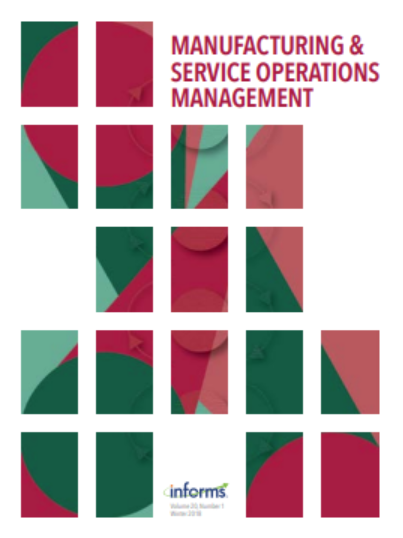未雨绸缪?偶然采购、装运信息和供应商竞争
IF 4.8
3区 管理学
Q1 MANAGEMENT
M&som-Manufacturing & Service Operations Management
Pub Date : 2023-09-01
DOI:10.1287/msom.2021.0540
引用次数: 0
摘要
问题定义:双重采购和应急采购是管理供应链风险的重要风险缓解战略,包括与运输相关的入境订单损失。临时采购作为管理运输风险的一种手段,可以通过在过境检查点或通过运输监测技术实现装运信息。我们研究了在买方可以从两个竞争供应商处采购的情况下,偶然采购和装运信息的影响。一个供应商(不可靠)运输周期长,容易在运输途中损失成品率;另一个供应商(可靠的)交货时间短,但不为零,没有产量损失。方法/结果:我们分析了一个多阶段博弈论模型,其中两个供应商在批发价格上竞争,然后买方决定初始订单数量。随后,买方可以根据货运信息向可靠的供应商下紧急订单,这将(可能不完全地)显示来自不可靠供应商的在途订单的状态。我们表明,买方将采取以下四种可能的采购策略之一:(1)最初只从不可靠的供应商采购,但根据更新的货运信息求助于可靠的供应商;(2)将其初始订单分散到两个供应商,但在需要时求助于可靠的供应商;(3)使其初始订单多样化,但不参与偶然的采购;或(4)从可靠的供应商处单独采购。有趣的是,偶然采购可能对买方有利,也可能不利于买方,因为它可能会缓和供应商之间的竞争。此外,买方的利益在装运信息的准确性上可能不是单调的。管理意义:买方必须设计其供应基础,使不可靠的供应商特别具有成本效益,如果买方要从偶然采购的可能性中获益。买方可能并不总是从提高装运信息准确性的操作改进中受益,因为它们可能会减弱供应商的竞争。补充材料:在线附录可在https://doi.org/10.1287/msom.2021.0540上获得。本文章由计算机程序翻译,如有差异,请以英文原文为准。
Forewarned Is Forearmed? Contingent Sourcing, Shipment Information, and Supplier Competition
Problem definition: Dual sourcing and contingent sourcing are important risk-mitigation strategies to manage supply chain risks, including transportation-related losses of inbound orders. Contingent sourcing as a means of managing transportation risk is made possible by shipment information realized at in-transit inspection points or through shipment monitoring technologies. We examine the impact of contingent sourcing and shipment information in a setting where a buyer can source from two competing suppliers. One supplier (unreliable) has a long transportation lead time and is prone to in-transit yield loss; the other supplier (reliable) has a short, but nonzero, lead time with no yield loss. Methodology/results: We analyze a multistage game-theoretical model in which the two suppliers compete on wholesale prices and then, the buyer determines initial order quantities. Later, the buyer can place an emergency order with the reliable supplier based on shipment information, which reveals (possibly imperfectly) the status of the in-transit order from the unreliable supplier. We show that the buyer will adopt one of four possible sourcing strategies: (1) initially source only from the unreliable supplier but resort to the reliable supplier contingent on the updated shipment information, (2) diversify its initial order across the two suppliers but resort to the reliable supplier if needed, (3) diversify its initial order and not engage in contingent sourcing, or (4) sole source from the reliable supplier. Interestingly, contingent sourcing may or may not benefit the buyer because it may soften the competition between suppliers. Moreover, the buyer’s profit may not be monotonic in the accuracy of shipment information. Managerial implications: The buyer must design its supply base so that the unreliable supplier is particularly cost efficient if the buyer is to benefit from the possibility of contingent sourcing. The buyer may not always benefit from operational improvements that enhance shipment information accuracy because they may soften supplier competition. Supplemental Material: The online appendix is available at https://doi.org/10.1287/msom.2021.0540 .
求助全文
通过发布文献求助,成功后即可免费获取论文全文。
去求助
来源期刊

M&som-Manufacturing & Service Operations Management
管理科学-运筹学与管理科学
CiteScore
9.30
自引率
12.70%
发文量
184
审稿时长
12 months
期刊介绍:
M&SOM is the INFORMS journal for operations management. The purpose of the journal is to publish high-impact manuscripts that report relevant research on important problems in operations management (OM). The field of OM is the study of the innovative or traditional processes for the design, procurement, production, delivery, and recovery of goods and services. OM research entails the control, planning, design, and improvement of these processes. This research can be prescriptive, descriptive, or predictive; however, the intent of the research is ultimately to develop some form of enduring knowledge that can lead to more efficient or effective processes for the creation and delivery of goods and services.
M&SOM encourages a variety of methodological approaches to OM research; papers may be theoretical or empirical, analytical or computational, and may be based on a range of established research disciplines. M&SOM encourages contributions in OM across the full spectrum of decision making: strategic, tactical, and operational. Furthermore, the journal supports research that examines pertinent issues at the interfaces between OM and other functional areas.
 求助内容:
求助内容: 应助结果提醒方式:
应助结果提醒方式:


